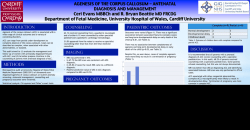
Agenesis of the Corpus Callosum (ACC)
Agenesis of the Corpus Callosum (ACC) Definition: ACC is a birth defect in which the corpus callosum is partially or completely absent. The corpus callosum, the main transverse tract of fibers that connects the two cerebral hemispheres, integrates motor, sensory, and cognitive functions. Description: While rare, ACC is actually one of the more common brain malformations observed in humans In this disorder, the corpus callosum may be partially or completely absent Incidence is typically identified as 2-3%; however, this is among individuals with cognitive disabilities For the general population the incidence is closer to 3-7/10,000 (<1%) Characteristics: Studies indicate that some individuals with ACC may have normal intelligence, while others are developmentally delayed. Agenesis of the corpus callosum is usually diagnosed during the first two years of life. The initial manifestation is usually the onset of seizures. The effects of the disorder range from subtle or mild to severe, depending on associated brain abnormalities. Common characteristics and observed difficulties include: Developmental delays Poor motor coordination Atypical sensory processing with a high tolerance to pain Difficulties on multidimensional or multimodality tasks (including auditory integration tasks) Challenges with social interactions Cognitive and social processing problems Limited insight into their own behavior Seizures Hydrocephalus Impairment of mental and physical development Mental retardation Impaired hand-eye coordination Midline facial defects (cleft lip, cleft palate, abnormal reduction of the distance between the eyes, single median maxillary incisor tooth, indistinct philtrum) Causes: Defects can occur when the corpus callosum does not develop typically during pregnancy. The corpus callosum develops between the 10th and 20th weeks of gestation. Abnormalities of the corpus callosum have no single cause. Contributing factors or causes can include: Maternal rubella Trisomy 8, 13 and/or 18 Andermann syndrome Aicardi syndrome Fetal Alcohol Syndrome Blockage of the growth of the corpus callosum. Due to the limited research that has been done on ACC, several theories are speculated to be the cause: Inherited X-linked dominant trait or an autosomal recessive trait An intrauterine infection during pregnancy Intrauterine exposure to alcohol (fetal alcohol syndrome) Implications for speech and language: Children with ACC can present with a wide range of speech and language abilities. ACC may cooccur with seizures and/or cognitive impairment, and individuals with ACC may have difficulty with auditory processing. Tasks requiring use of both hemispheres of the brain will be challenging for individuals with ACC. Additionally, these individuals may have difficulty monitoring or selfevaluating their answers and initially need a high degree of support, including modeling and cueing (Brennan, 2006). Resources: Books for Parents: Healy, Jane M. Your Child’s Growing Mind: Brain Development and Learning from Birth to Adolescence. New York: Broadway, 2004. Porter, Dianne M. Agenesis of the Corpus Callosum: the Beast Within. [S.l.]: Iuniverse, 2010. Doidge, Norman. The Brain That Changes Itself: Stories of Personal Triumph from the Frontiers of Brain Science. New York: Viking, 2007. Booklet Series: Disorders of the Corpus Callosum Volume 1- Introduction to the Agenesis of the Corpus Callosum by Lynn Paul PhD Books for Children: Schilmoeller, Kathryn J., Lynn K. Paul, and Cindy Mauro Reisenauer. ACC and Me. [United States]: NODCC, 2007. Support Groups/Internet Sites: The National Organization for Disorders of the Corpus Callosum (NODCC) National Organization for Rare Disorders (NORD) National Institute of Neurological Disorders and Stroke Yahoo Groups: Agenesis_ of_ Corpus_ Callosum ACCKIDS Babieswithacc ACC-Texas References: Agenesis of the Corpus Callosum. (2012, January 26). In The Fetal Treatment Center UCSF. Retrieved from http://fetus.ucsfmedicalcenter.org/corpus_callosum/ Brennan, Christine. Agenesis of the Corpus Callosum (ACC): An Overview for SLPs. (2006). Retrieved from: http://www.docstoc.com/docs/522711/Agenesis-of-the-Corpus-Callosum NINDS Agenesis of the Corpus Callosum Information Page. (2011, February 7). In National Institute of Neurological Disorders and Stroke. Retrieved from http://www.ninds.nih.gov/disorders/agenesis/agenesis.htm.
© Copyright 2025





















